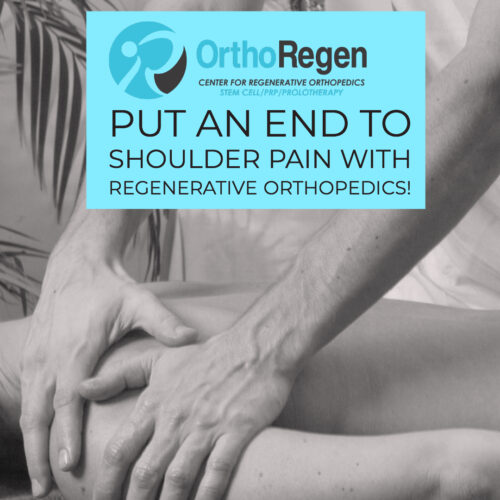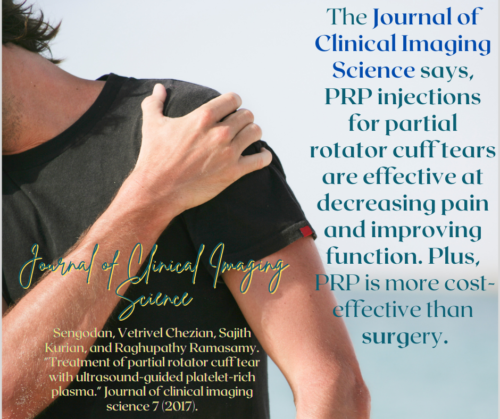
Stop Pain from Rotator Cuff Injuries and Other Shoulder Problems
Many of us really enjoy participating in indoor and outdoor activities. Our favorite sport or activity might include swimming, golfing, bicycling, playing tennis, volleyball, or another favorite sport. But injuries to the shoulder are common. How do you stop pain from rotator cuff injuries and other shoulder problems?
The shoulder is a unique joint in that it is incredibly flexible. The shoulder joint is one of the body’s ball and socket joints, equipped with a huge range of motion. That’s a great feature! Why? Because so many of the activities the shoulder is called upon to perform require mobility and flexibility.
But there is a balance between flexibility and the maintenance of joint stability. The downside of all that flexibility and motion is injury and instability. And that unfortunately results in pain and impaired function! Athletes such as pitchers, quarterbacks, tennis players, and swimmers, are prone to shoulder injuries. These sports all require repetitive overhead movements. Even golfers suffer regularly from shoulder injuries due to the positioning in the backswing, which commonly affects the non-dominant shoulder. Jobs requiring repeated overhead motion, like painting, can aggravate the shoulder as well and lead to shoulder injury and pain.
Aggressive, repetitive use can cause ligaments to stretch out and elongate. Does your shoulder click and clunk? That’s not normal. But it is a result of stretched-out soft tissue and abnormal motion in the shoulder joint. Unfortunately, the ligaments do not have much of a blood supply. And when injured, the lower blood supply means ligament healing can be insufficient. If complete healing does not occur, then the abnormal joint motion from unstable ligaments continues.
Damaged ligaments need time to remodel and repair. For instance, a tennis player with shoulder pain may need to reduce training hours and allow for proper rest time between workouts. The same is true for the golfer, swimmer, pitcher, and painter! With inadequate healing, the shoulder becomes unstable and will start making a clunking or clicking noise. When this occurs with every stroke or swing motion, it can indicate a more severe, multidirectional shoulder instability. The shoulder joint at this point is moving abnormally in a variety of directions, generating more shoulder injury and provoking shoulder pain.
Have you or someone you know suffered from a rotator cuff injury? It’s quite a common shoulder injury. A rotator cuff is a group of four muscles and tendons surrounding the glenohumeral joint. The function of the rotator cuff is to provide motion for activities above the waist and shoulders. Because of this, injuries to this group of muscles and tendons often transpire with overhead activities.
Ongoing instability causes strain and weakness in the rotator cuff muscles, which persists at fatiguing the muscles. This will alter the way they function and move, and can lead to injury to other shoulder structures. You can picture how continuing to use poor form, or persisting to work out with an injured shoulder, can set the sufferer on an ongoing course of abnormal joint motion and shoulder injury. Continued overuse results in increased instability, a weaker rotator cuff, and an eventual tear and shoulder degeneration.
Another affliction common to the shoulder is a glenoid labrum injury. The glenoid labrum is a very important structure because it stabilizes the shoulder. The glenoid is the shoulder socket and the labrum is basically the soft tissue surrounding the socket. A tear to this soft tissue labrum is prevalent in workers who do a lot of manual labor and is also a common injury in athletes.
This shoulder injury can occur in a traumatic event, through repetitive motion, or with recurrent dislocations. When the labrum is torn, other ligaments and tendons surrounding the shoulder are often injured too. So if the forces involved in the injury were significant enough to tear the labrum, they were most likely also sufficient to injure the ligaments or tendons.
Keep this in mind when seeking repair, because all of the injured shoulder structures need to be treated to have a completely healed shoulder joint. Otherwise, the healing will be incomplete, and a cycle of shoulder injury, shoulder re-injury, and shoulder pain is set in motion.
Surgery is commonly sought to stop pain from rotator cuff injuries and labral tears, but the correction is often ineffective. Why is that? The reason is that surgery, including arthroscopic treatment, involves the removal or debridement of the shoulder structures. When these structures are removed, the shoulder joint is left more unstable, and prone to re-injury!
Guess what happens when the instability is not repaired? The ongoing abnormal movement will eventually result in the development of arthritis. That’s because the body will try to stop the movement or stabilize the shoulder by growing more bone! More instability results in more problems and more shoulder pain.
Conservative treatments such as non-steroidal anti-inflammatories (NSAIDs) and corticosteroids are often recommended too. And although they may give some short-term pain relief, these treatments do not resolve the underlying soft tissue tears and shoulder injury. Sadly, these treatments inhibit healing and further the problem they are given for in the first place. The shoulder pain sufferer is then left with unhealed soft tissue in the shoulder, abnormal motion, and continued pain.

PRP is effective at reducing shoulder pain
When shoulder injuries do occur or when injuries do not heal properly despite trials of multiple treatment modalities, an effective option is available. Non-Surgical Regenerative Orthopedics, such as Stem Cell Therapy, Prolotherapy, and PRP are treatments that can be utilized to treat and repair shoulder injuries such as glenoid labral tears and rotator cuff injuries. These treatments work because they correct the underlying problem and naturally alleviate shoulder pain.
Prolotherapy, Stem Cell Therapy, and PRP require almost no downtime. They are ideal for athletes who need to continue training, the weekend golfer who doesn’t want to stop their beloved sport, and the painter who cannot afford much downtime. Shoulder injuries often need a treatment that restarts or reboots the ability to repair, and these regenerative therapies do just that. Shoulder instability, rotator cuff injuries, glenoid labral tears (as long as the tear is not complete), and pain can be successfully addressed with these regenerative medicine techniques.
Prolotherapy, Stem Cell Therapy, and PRP are designed to help repair the painful shoulder without cutting, suturing, sewing, or stapling. This is a natural injection therapy that strengthens loose and unstable shoulder joints and the involved ligaments and tendons, creating a more stable, strong, and pain-free shoulder. And this results in the active person being able to continue working or engaging in the sports and activities they love!
1Sengodan, Vetrivel Chezian, Sajith Kurian, and Raghupathy Ramasamy. “Treatment of partial rotator cuff tear with ultrasound-guided platelet-rich plasma.” Journal of clinical imaging science 7 (2017).
2Mora, Maria Valencia, et al. “Stem cell therapy in the management of shoulder rotator cuff disorders.” World Journal of Stem Cells.4 (2015): 691.